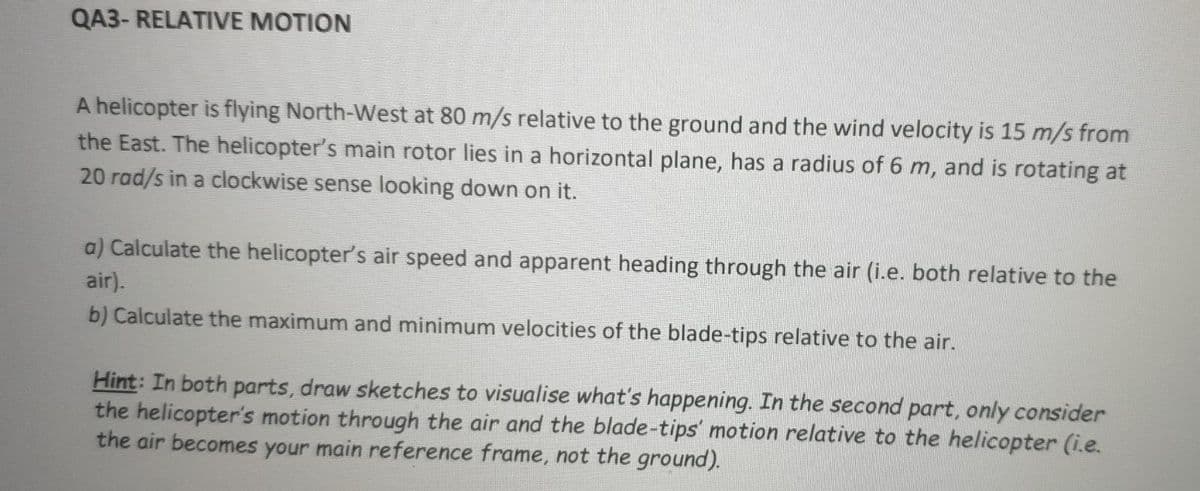QA3- RELATIVE MOTION A helicopter is flying North-West at 80 m/s relative to the ground and the wind velocity is 15 m/s from the East. The helicopter's main rotor lies in a horizontal plane, has a radius of 6 m, and is rotating at 20 rad/s in a clockwise sense looking down on it. a) Calculate the helicopter's air speed and apparent heading through the air (i.e. both relative to the air). b) Calculate the maximum and minimum velocities of the blade-tips relative to the air. Hint: In hoth
QA3- RELATIVE MOTION A helicopter is flying North-West at 80 m/s relative to the ground and the wind velocity is 15 m/s from the East. The helicopter's main rotor lies in a horizontal plane, has a radius of 6 m, and is rotating at 20 rad/s in a clockwise sense looking down on it. a) Calculate the helicopter's air speed and apparent heading through the air (i.e. both relative to the air). b) Calculate the maximum and minimum velocities of the blade-tips relative to the air. Hint: In hoth
International Edition---engineering Mechanics: Statics, 4th Edition
4th Edition
ISBN:9781305501607
Author:Andrew Pytel And Jaan Kiusalaas
Publisher:Andrew Pytel And Jaan Kiusalaas
Chapter1: Introduction To Statics
Section: Chapter Questions
Problem 1.19P: Plot the earths gravitational acceleration g(m/s2) against the height h (km) above the surface of...
Related questions
Question

Transcribed Image Text:QA3- RELATIVE MOTION
A helicopter is flying North-West at 80 m/s relative to the ground and the wind velocity is 15 m/s from
the East. The helicopter's main rotor lies in a horizontal plane, has a radius of 6 m, and is rotating at
20 rad/s in a clockwise sense looking down on it.
a) Calculate the helicopter's air speed and apparent heading through the air (i.e. both relative to the
air).
b) Calculate the maximum and minimum velocities of the blade-tips relative to the air.
Hint: In both parts, draw sketches to visualise what's happening. In the second part, only consider
the helicopter's motion through the air and the blade-tips' motion relative to the helicopter (i.e.
the air becomes your main reference frame, not the ground).
Expert Solution
This question has been solved!
Explore an expertly crafted, step-by-step solution for a thorough understanding of key concepts.
Step by step
Solved in 4 steps

Knowledge Booster
Learn more about
Need a deep-dive on the concept behind this application? Look no further. Learn more about this topic, mechanical-engineering and related others by exploring similar questions and additional content below.Recommended textbooks for you

International Edition---engineering Mechanics: St…
Mechanical Engineering
ISBN:
9781305501607
Author:
Andrew Pytel And Jaan Kiusalaas
Publisher:
CENGAGE L

International Edition---engineering Mechanics: St…
Mechanical Engineering
ISBN:
9781305501607
Author:
Andrew Pytel And Jaan Kiusalaas
Publisher:
CENGAGE L